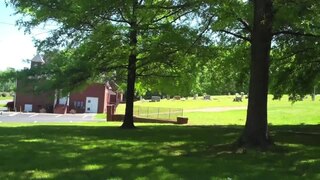
The Rosenwald School project built more than 5,000 schools, shops, and teacher homes in the United States primarily for the education of African-American children in the South during the early 20th century. The project was the product of the partnership of Julius Rosenwald, a Jewish-American clothier who became part-owner and president of Sears, Roebuck and Company and the African-American leader, educator, and philanthropist Booker T. Washington, who was president of the Tuskegee Institute.

Arkansas Baptist College (ABC) is a private Baptist-affiliated historically black college in Little Rock, Arkansas. Founded in 1884 as the Minister's Institute, ABC was initially funded by the Colored Baptists of the State of Arkansas. It is the only historically black Baptist school west of the Mississippi River. The Main Building on its campus, built in 1893, is one of the oldest surviving academic buildings in the state, and was listed on the National Register of Historic Places in 1976.
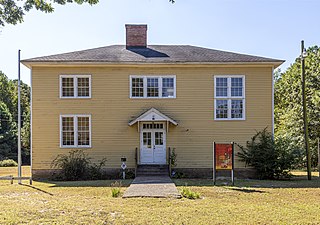
San Domingo School, also known as Sharptown Colored School and Prince Hall Masons Unity Lodge No. 73, is a historic Rosenwald School building located at Sharptown, Wicomico County, Maryland. It was built in 1919, and is a two-story, rectangular frame building with a hipped roof. It is one of four surviving Rosenwald schools in Wicomico County. The school had only four teachers and remained in use as a school until 1957.
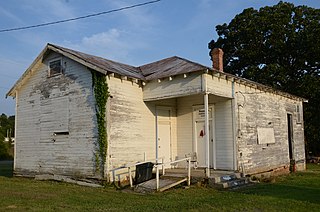
The Bigelow Rosenwald School, also known as Rosenwald Community Center, is a former Rosenwald School located in Toad Suck, about 10 miles (16 km) northeast of Bigelow, Perry County, Arkansas. Built in 1926, it is a single-story wood-frame building with vernacular Craftsman elements. It served as a school until 1964, when it became a community center. It is the only Rosenwald School building that still stands in Perry County.
Mount Olive is an unincorporated community in Bradley County, Arkansas, United States. It is the location of Mt. Olive Rosenwald School, which is located on Bradley Rd. 45 and is listed on the National Register of Historic Places. Goepel was previously the name used for Mount Olive.

Liberty Colored High School is a former high school for African-American students in Liberty, South Carolina during the period of racial segregation. It originally was called Liberty Colored Junior High School. The building is now a community center known as the Rosewood Center. It is at East Main Street and Rosewood Street in Liberty. The school was built in 1937 on the site of a Rosenwald school that had burned down.
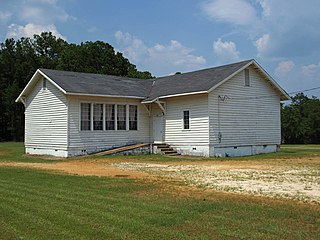
The Mount Sinai School is a historic Rosenwald School in rural Autauga County, Alabama, USA, northwest of Prattville. The one-story frame building was built in 1919 to the designs of W.A. Hazel to serve the local African American community. The money to build it was provided by the Julius Rosenwald Fund. The school was added to the Alabama Register of Landmarks and Heritage on February 2, 2001. It was subsequently listed on the National Register of Historic Places on November 29, 2001, as a part of The Rosenwald School Building Fund and Associated Buildings Multiple Property Submission.

Rosenwald School is a Rosenwald school on Arkansas Highway 26 in Delight, Arkansas. The school, a single-story wood-frame structure with a gable roof, was built in 1938 by the Works Progress Administration. Philanthropist Julius Rosenwald sponsored the Rosenwald schools to provide education for African-Americans in rural communities; the Julius Rosenwald Fund helped build 389 schools in Arkansas, including the one in Delight. The school closed in the 1970s, when many of the Rosenwald schools closed due to desegregation. It is now used as a local community center.

The Chicot County Training School was a historic school building at the corner of Hazel and North School Streets in Dermott, Arkansas. The single story H-shaped building was built in 1929 with funding support from the Rosenwald Fund, a major philanthropic effort to improve educational opportunities for African-Americans. The school was preceded by Dermott Baptist Industrial School, co-founded by Isaac George Bailey, and then Morris Booker High School and Memorial College. It was succeeded by Morris Booker Memorial College. The building was listed on the National Register of Historic Places in 2004. The school building collapsed and burned after being abandoned. It was delisted from the National Register in 2022.

Mt. Zion Rosenwald School, also known as Mt. Zion-Rosenwald Colored School, is a historic Rosenwald School building located near Florence, Florence County, South Carolina. It was built in 1925, and is a rectangular frame building with tall exterior windows. It is a "two or three teacher" school building. Construction of the project was funded in part by the Julius Rosenwald Fund, which helped build more than 5,300 black school buildings across the south from 1917 to 1932.

The Dallas County Training School High School Building is a historic school building at 934 Center Street in Fordyce, Arkansas. Built in 1934 with funding from the Rosenwald Fund, it was the only high school serving African Americans in a four-county region of southern Arkansas until 1940. Its original block is a rectangular brick structure with a gable-on-hip roof; a flat-roof addition was made to the rear in 1954. The building house grades 6-12 of African Americans until 1970, when the city's schools were integrated. At that time it became an elementary school, and was finally closed in 2001.
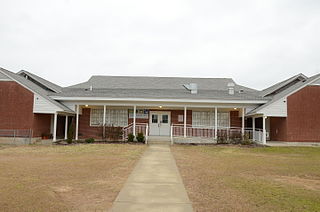
The Peake High School is a historic school building at 1600 Caddo Street in Arkadelphia, Arkansas. This H-shaped single-story brick building was built in 1929 with assistance from the Rosenwald Fund on land given by J. Ed Peake, a school principal for whom the school was named. The building was used as a high school for African Americans until 1960, when a new building was constructed adjacent to this one, which was converted to an elementary school. The city's public schools were integrated in 1969. The school housed the city's Head Start Program from 1984 to 2001. It is the only surviving Rosenwald school in the county.
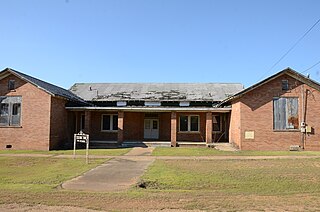
The Lafayette County Training School is a historic school building at 1046 Berry Street, on the former campus of Ellis High School in Stamps, Arkansas. It is a single-story brick building with a gable roof, built-in 1929 with assistance from the Rosenwald Fund. It is laid out in the shape of an H, and houses six classrooms in the side wings, with an office, library, and auditorium in the center. It is the only surviving Rosenwald School in Lafayette County. It served the area's African-American student population until 1969 when the county schools were integrated. It thereafter served as an integrated middle school until 1975, and for a time as a daycare center afterwards.

The Oak Grove Rosenwald School is a historic school building on Oak Grove Road in Oak Grove, a small settlement in southeastern Sevier County, Arkansas. It is a single-story wood-frame structure, built in 1926 with financial assistance from the Rosenwald Fund. It has two classrooms, and is based on a standard plan developed by Samuel Smith, an agent for the Rosenwald Fund, for this type of small community school. It was probably used for the education of local African Americans until the state's schools were integrated, and is the only surviving Rosenwald school in the county.

The Kiblah School is a historic school building in rural Miller County, Arkansas. It is located southeast of Doddridge, at the junction of County Roads 4 and 192, between United States Route 71 and the Red River. The building is a single-story L-shaped wood-frame structure, topped by a gable-on-hip roof. It has modest Craftsman styling, with some Greek Revival influences. The main entrance is sheltered by a hip-roofed porch supported by Craftsman-style columns. It has a transom window reminiscent of Greek Revival doorways. The school was built in 1927 with funding from the Rosenwald Fund, and was intended to serve the African-American community of Kiblah, which was established after the American Civil War by former slaves from a Louisiana plantation.
The Fargo Training School in Fargo, Arkansas was founded as a private school initially known as the Fargo Agricultural School. It was an historically important school from the segregation era, and its surviving campus was listed on the National Register of Historic Places in 2010. The campus includes five historic buildings.

The Malvern Rosenwald School is a historic school building at 836 Acme Street in Malvern, Arkansas. It is a T-shaped single-story brick building, with a gable roof over its original main section. A gable-roofed entry is centered on the eastern facade. Additions extend the original block to the left of the entrance, the last one with a flat roof. The school was built in 1929 with funding assistance from the Rosenwald Fund, but did not follow a standard Rosenwald plan. It first served African-American students in grades 1–9, but was gradually expanded to include high school students. The high school students were reassigned to a new school in 1952, after which it became the Tuggle Elementary School. Both schools were closed around the time that Malvern's schools were integrated, in 1970.

The Little River County Training School Historic District encompasses the surviving buildings of a defunct once-segregated vocational school in Ashdown, Arkansas. It occupies two city blocks, bounded by Martin Luther King, Jr. Drive, and Hamilton, Wood, and Byrne Streets. The surviving buildings are a classroom building, the gymnasium, and the shop building. All are single story brick structures, and were built between 1962 and 1965. They represent the last surviving buildings in Little River County that were used as segregated facilities. The school was first developed in the 1920s, with funding and other support from the Rosenwald Fund; a building burned down in 1957, and another in 1980. The school was used in an integrated setting, mainly as a junior high school, until 1979, when the new Junior High opened for the 1979–1980 school year. The building on Hamilton Street was utilized as a Primary Center until it burned, in 1980.
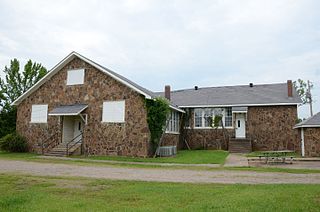
The Union Chapel School and Shop Building is a historic school complex in rural Conway County, Arkansas. It is located at the junction of Union Chapel Road and Acker Lane, about 2.5 miles (4.0 km) south of Springfield. It consists of three buildings: a classroom, shop building, and pump house. The classroom building is a stone single-story structure, with a gable roof, and bands of sash windows flanking the main entrance, which is set in a rounded-arch opening. The shop building is also stone, and is covered by a hip roof. The shop building was one of several built on the grounds in the late 1920s with funding from the Rosenwald Fund, and is the only one from that period to survive. The classroom building was built in 1937–38 with funding from the Works Progress Administration, replacing one of the Rosenwald buildings that had burned down.

The Thomas Jefferson Elder High and Industrial School, at 316 Hall St. in Sandersville, Georgia, was listed on the National Register of Historic Places in 1981. It is a Rosenwald school built in 1927. It competed in the Georgia Interscholastic Association.




















